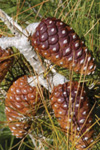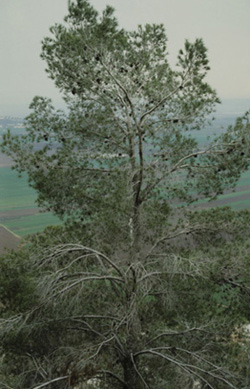

Serotinous cones of Aleppo pine (Pinus halepensis) in March, planted as part of a restoration effort at the Jebel Abdel Aziz Preserve, northern Mesopotamia, Syria. The reflexed cones borne on stalks are characteristic of this species.
EVERYONE KNOWS THE GENERAL architecture of a pine tree, that it has cones, and that the sap of the tree is resinous and sticky. Because of this familiarity, some of the trees in the Bible may have been translated erroneously as pine; it remains unclear whether these gymnosperm trees were intended in the text.
Three pines are frequently encountered in the Middle East: stone pine, Aleppo pine (after Aleppo, Syria), and Calabrian (after Italy’s Calabria region) pine. Pinus pinea, the stone pine (so-called because of its hard seeds), also known as umbrella pine (an allusion to its umbrella-like appearance when mature), is grown for its seeds (pine nuts), an important ingredient in Middle East foods. (Pinyon nuts are also pine seeds, but from a native North American pine.) Today, most of these seeds are imported from China and may be produced by trees other than the stone pine. And there is evidence that cultivation of stone pine, a Mediterranean species, was not widespread in ancient times (Biger and Liphschitz 1991).
The two native pines are Aleppo pine, Pinus halepensis (ironically apparently not native to Aleppo), and Calabrian pine, P. brutia. Some forests of Aleppo pine remain in Israel and Jordan. Biger and Liphschitz (1991) suggest that P. brutia was absent from what is modernday Israel, being more common farther north. Calabrian pine is widespread in Syria and Turkey. Liphschitz and Biger (2001) present convincing evidence that Aleppo pine also was not formerly widespread in what is modern-day Israel and Jordan.

Aleppo pine, Pinus halepensis, in April, on a ridge above the Jizreel Valley, Israel. This pine has persistent lower branches, indicative of a tree adapted to fire ecology.
The two species Pinus halepensis and P. brutia are quite similar, so I have difficulty distinguishing them. They are immediately recognizable as pines because of the typical architecture of branches and the leaves (needles) that pines have. Despite their similarity, there is convincing evidence that they represent two distinct species (Madmon et al. 2003). Both pines belong to a guild of plants associated with fire-maintained communities.
Among their adaptations to fire are persistent lower branches that can carry flame to the crowns of the trees, where the cones will open in response to heat. Both of these pines have serotinous cones: retention of mature seeds in cones in a canopy-stored seed bank that ensures delayed dispersal (Ne’eman et al. 2004). In general, pines that have nonpruning branches do not produce the most desirable timber because of the presence of knots that weaken the ability of the wood to carry weight. Therefore, it is unlikely that pine was used in the ancient Middle East in the same way as, for example, cedar or open-grown (in contrast to fastigate) cypress, which have long boles (the distance from the ground to the first branch).
In light of these considerations, is pine mentioned anywhere in the Bible? I do not think it is possible to say with certainty that any verses explicitly refer to pine. However, there is one pine product that is often overlooked in the context of the Bible. That is pitch, the material extracted from pine trees for caulking ships and sealing wine amphoras. Both Pinus halepensis and P. brutia are recorded as producing pitch and turpentine in the ancient Mediterranean (Meiggs 1982), though these materials are lacking in Egyptian archaeology (Serpico 2000). It could be that the pitch used in constructing Noah’s ark was derived from pine: “So make yourself an ark of cypress wood; make rooms in it and coat it with pitch inside and out” (Genesis 6:14, NIV). The basket into which baby Moses was placed was coated with pitch, likely derived from pine, as well as bitumen: “But when she could hide him no longer, she got a papyrus basket for him and coated it with tar and pitch. Then she placed the child in it and put it among the reeds along the bank of the Nile” (Exodus 2:3, NIV). An entirely different use is reported by Levey (1954): that resin from gymnosperms was used in the Assyrian empire for the production of soap.

Forest of Aleppo pine near Dibbeen, Jordan. Fire plays an important role in the reproduction of this species as with many pines.

Cones of pine, likely Pinus brutia, carved on Roman ruins at Palmyra, Syria. The inclusion of this pine in this relief suggests that the plant was well known and valued.
Whether pine can be documented in the Bible or not, the tree is an important and conspicuous element of the landscape in areas of the Levant with higher rainfall.